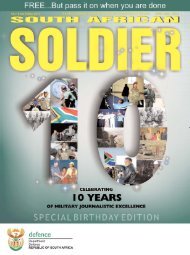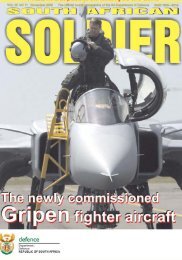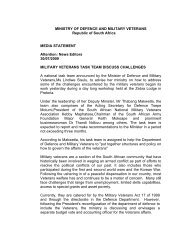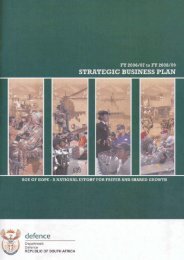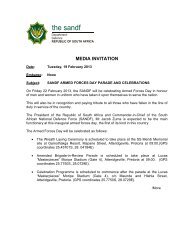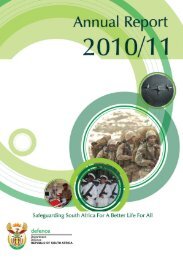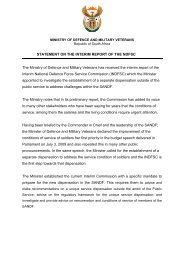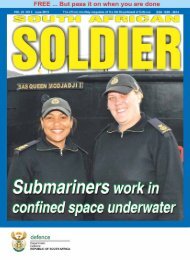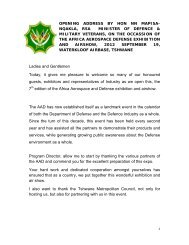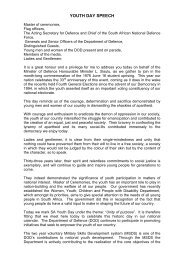Chapter 2 - P rogramme 1 - Department of Defence
Chapter 2 - P rogramme 1 - Department of Defence
Chapter 2 - P rogramme 1 - Department of Defence
Create successful ePaper yourself
Turn your PDF publications into a flip-book with our unique Google optimized e-Paper software.
Overview<br />
| <strong>Department</strong> <strong>of</strong> <strong>Defence</strong> |<br />
CHAPTER 3<br />
P<strong>rogramme</strong> 8: Force Employment<br />
Through the Force Employment P<strong>rogramme</strong>, the<br />
command and control, as well as the coordination<br />
<strong>of</strong> all SANDF forces employed in various missions,<br />
is executed and directed.<br />
The SANDF fully complied with all commitments<br />
in terms <strong>of</strong> missions ordered by the Government.<br />
The SANDF successfully employed mission-trained<br />
forces in terms <strong>of</strong> South Africa’s policies and<br />
international obligations in order to promote peace,<br />
safety, security, stability and cooperation.<br />
<strong>Defence</strong> actively supported peace, security and<br />
stability missions in Africa. Approximately 2 500<br />
members, including Reserves, were employed in six<br />
peace support and six general military assistance<br />
operations in the DRC, Sudan, Burundi, Ethiopia<br />
and Eritrea, Uganda, Central African Republic<br />
(CAR), the Comoros and Mozambique. For the<br />
first time, the SANDF deployed personnel outside<br />
the Continent when five military observers were<br />
deployed in support <strong>of</strong> the UN mission in Nepal<br />
(Operation INDULI). In the DRC, the SANDF<br />
continued to support the ongoing peace operations.<br />
The SANDF contingent deployed in Sudan under<br />
the AU helped to stabilise the fragile peace process<br />
in the Darfur region. The UN/AU Hybrid Mission<br />
will see the strength <strong>of</strong> the South African contingent<br />
increase during the next rotation in May 2008.<br />
Military observers were also deployed in support <strong>of</strong><br />
the AU peace initiative in Uganda. Furthermore, the<br />
SANDF has pledged force capabilities towards the<br />
establishment <strong>of</strong> the SADC Brigade (SADCBRIG)<br />
as part <strong>of</strong> the AU Standby Force. The SADCBRIG<br />
was formally launched on 17 August 2007 in Lusaka,<br />
Zambia.<br />
In addition to the participation in peacekeeping<br />
operations, the SANDF participated in six general<br />
military assistance operations during the year<br />
under review. In contributing to post-conflict<br />
reconstruction activities in the DRC, the SANDF<br />
continued supporting the DRC Armed Forces<br />
with the integration process and by the end <strong>of</strong><br />
March 2008, 164 729 Congolese combatants had<br />
completed the identification and registration process.<br />
In accordance with a bilateral agreement with the<br />
Central African Republic (CAR), the SANDF<br />
deployed personnel to the CAR to assist with training<br />
and post-conflict reconstruction. CAR soldiers also<br />
received training in South Africa. With reference to<br />
humanitarian assistance, support was provided to<br />
Mozambique during the recent floods and technical<br />
assistance following the country’s ammunition<br />
depot disaster. The SANDF assisted Mozambique<br />
with the destruction <strong>of</strong> 1 213 tons <strong>of</strong> unexploded<br />
ordnance as well as the Ugandan Government with<br />
the disposal <strong>of</strong> 280 tons <strong>of</strong> munitions.<br />
Internally, several missions in support <strong>of</strong> other<br />
Government departments were conducted. Worthy<br />
<strong>of</strong> noting is Operation BATA in June 2007.<br />
Operation BATA saw the SANDF provide rapid<br />
and full response to the requirement by Government<br />
to support the people <strong>of</strong> South Africa during the<br />
public sector strike. This saw the SANDF deploy<br />
its members within 24 hours <strong>of</strong> receiving the order.<br />
The SA Military Health Service (SAMHS) was the<br />
lead Service during the operation, the details <strong>of</strong><br />
which are described under P<strong>rogramme</strong> 5.<br />
In support <strong>of</strong> the SA Police Service (SAPS), the<br />
emphasis was on borderline control and rural<br />
safeguarding operations. The phased withdrawal<br />
<strong>of</strong> the SANDF from borderline control and rural<br />
safeguarding and the handover to the <strong>Department</strong> <strong>of</strong><br />
Safety and Security continued, with the international<br />
borders pertaining to Mozambique and Swaziland<br />
handed over to the SAPS for future safeguarding<br />
and management. This resulted in a reduction<br />
<strong>of</strong> internally deployed SANDF force levels. The<br />
handing-over and taking-over process between the<br />
SANDF and the SAPS will continue as a phased<br />
process until the end <strong>of</strong> FY 2008/09, in accordance<br />
with the approved SAPS Entry/SANDF Exit<br />
Strategy. Thus the number <strong>of</strong> personnel safeguarding<br />
the borders <strong>of</strong> South Africa has been reduced,<br />
which sees a concomitant decrease in the number<br />
<strong>of</strong> undocumented migrants from neighbouring<br />
countries being apprehended, as compared to the<br />
previous years. Close cooperation was strengthened,<br />
and the SAPS, the <strong>Department</strong> <strong>of</strong> Home Affairs and<br />
the SANDF assisted in repatriating undocumented<br />
migrants.<br />
89 Annual Report FY 2007 - 2008<br />
| <strong>Chapter</strong> 3 - P<strong>rogramme</strong> 8: Force Employment |



